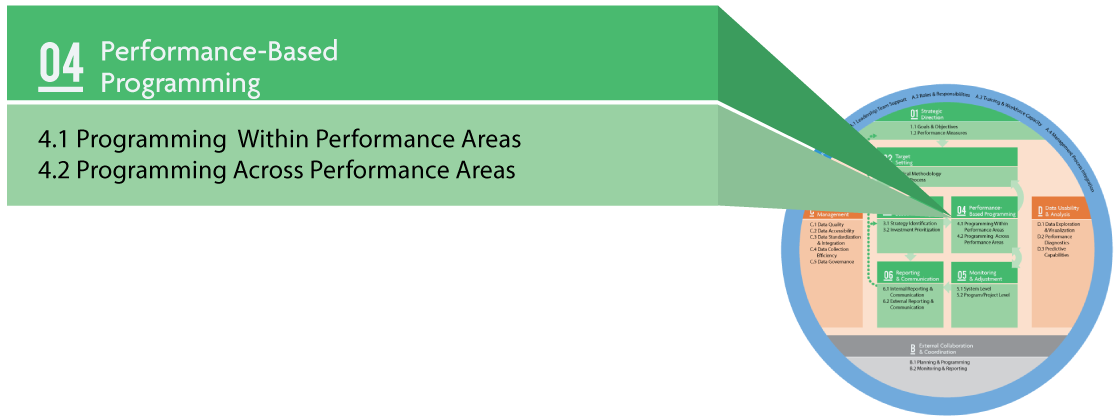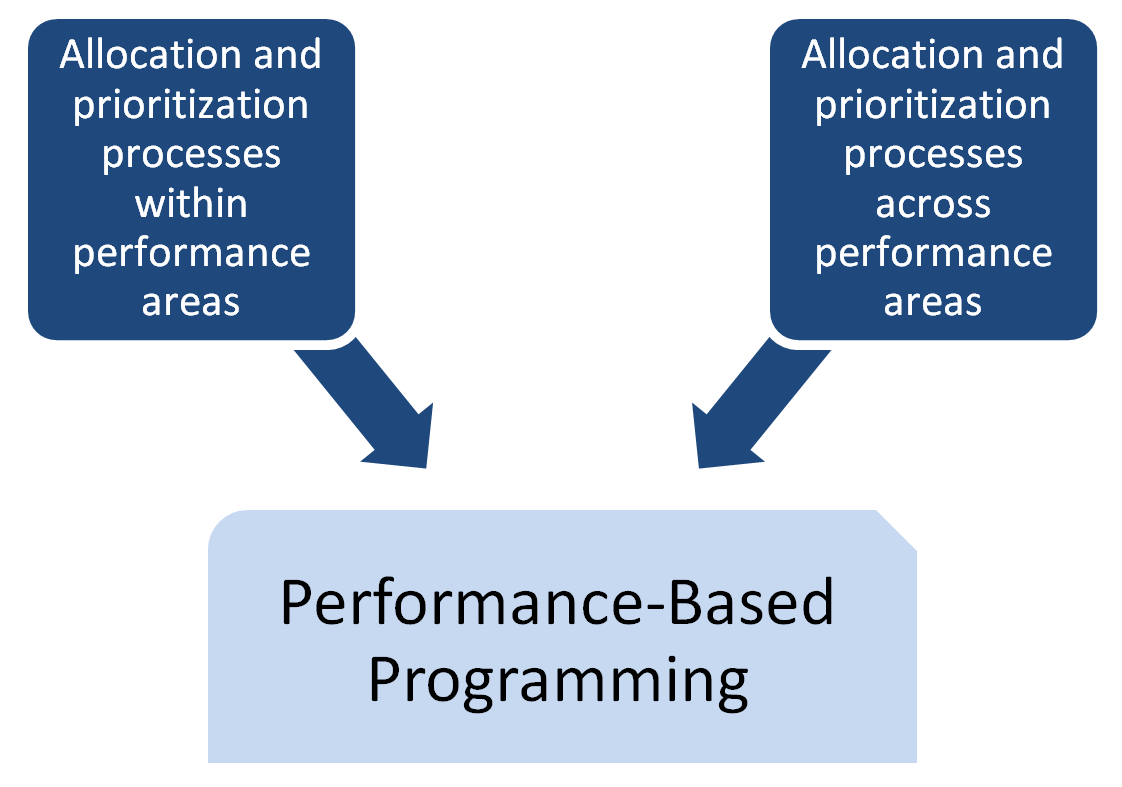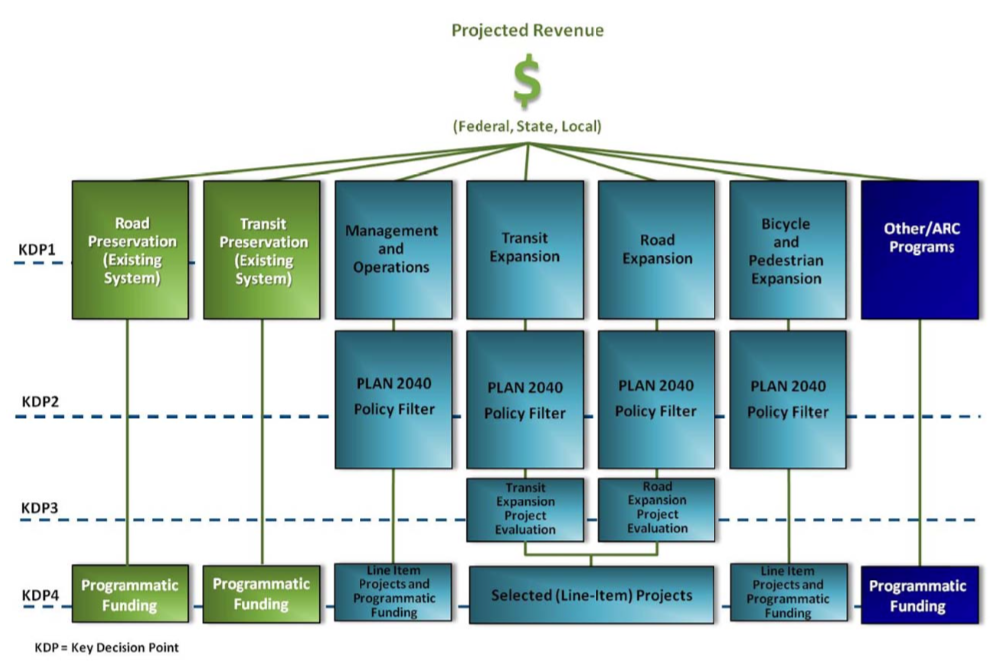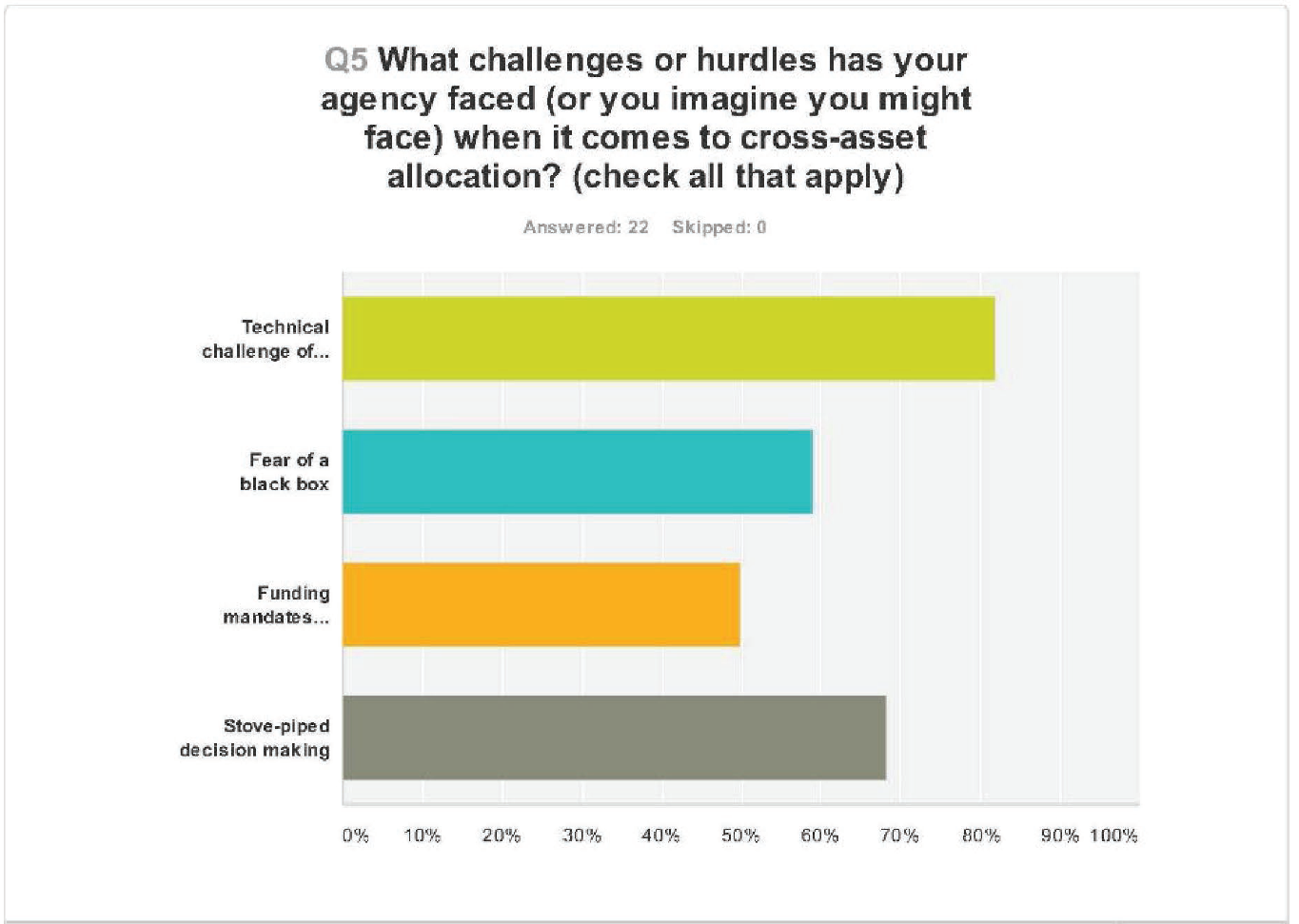Component 04
Performance-Based Programming
This chapter provides assistance to transportation agencies with the Performance-Based Programming component of Transportation Performance Management (TPM). It discusses where performance-based programming occurs within the TPM Framework, describes how it interrelates with the other nine components, presents definitions for associated terminology, provides links to regulatory resources, and includes an action plan exercise. Key implementation steps are the focus on the chapter. Guidebook users should take the TPM Capability Maturity Self-Assessment as a starting point for enhancing TPM activities. It is important to note that federal regulations for performance-based programming may differ from what is included in this chapter.
Performance-Based Programming uses strategies and priorities to guide the allocation of resources to projects that are selected to achieve goals, objectives, and targets. Performance-based programming establishes clear linkages between investments made and expected performance outputs and outcomes.
Introduction to Performance-Based Programming
Performance-based programming uses the strategies and priorities established under performance-based planning to guide the allocation of resources to projects in order to achieve strategic goals, objectives, and performance targets. Performance-based programming establishes clear linkages between investments made and their expected outputs and outcomes.
In performance-based programming, the planning strategies included in long-range transportation plans (LRTP) and other performance-based plans translate into project selection criteria. Agencies use the project selection criteria to allocate resources to specific projects and programs with the aim of achieving strategic goals, objectives, and performance targets established in the Strategic Direction (Component 01) and documented in the LRTP and other plans created during the Performance-Based Planning process (Component 03).
Completing a round of performance-based programming will result in two key products: a number of metropolitan planning organization (MPO) Transportation Improvement Program (TIP) documents and a State Transportation Improvement Program (STIP). These documents identify projects that will be funded, the timeframe for implementation, and the sources of funding that are being committed. Projects included in the STIP and TIP, when completed, should move the agency toward attainment of goals, objectives, and performance targets; these documents continue the linkage between the Strategic Direction, Target Setting, and Performance-Based Planning. To support development of the STIP and TIP, agencies can engage in scenario planning,1 or take an analytical approach to evaluating how various combinations of strategies (scenarios) may impact system performance.2 The STIP must incorporate projects shown in all MPO TIPs in the state, as well as transit projects. Inclusion in the STIP makes the project eligible for federal funding.3
A performance-based approach to programming is focused on project outcomes and how projects can push progress toward goals, objectives, and performance targets.
In this data-driven decision structure, a number of key factors should be incorporated:
- Influencing factors such as how the political context will affect what projects are programmed.
- Internal collaboration across performance areas within an agency must be evaluated. It is critical to challenge silo-based programming and budgeting and weigh and document tradeoffs between performance areas. Funding will be divided amongst preservation, expansion, and other areas; the tradeoffs should be understood, agreed upon, communicated, and documented to build and maintain support for performance-based programming.
- External stakeholder involvement from partner agencies, the public, and policy makers is needed to reaffirm the commitment to agency goals, objectives and performance targets.
- Funding and resource constraints should be considered from the outset. Since different projects qualify for different types of funding, a full menu of how monies and resources could be applied is vital to understanding the possibilities for programming considering varying constraints associated with federal and other funding programs.4
While performance-based planning and performance-based programming (PBPP) are often discussed as one process, there are important differences between them. This guidebook heavily references FHWA’s “Performance Based Planning and Programming Guidebook”5 while separating the planning and programming processes to highlight:
- Differences and interconnections between planning and programming processes by demonstrating the role they play in implementing TPM, and
- Clear linkage between strategies and goals to determine investment priorities; and
- How to implement a PBPP process as part of TPM.
Subcomponents and Implementation Steps
Figure 4-1: Subcomponents for Performance-Based Programming
Source: Federal Highway Administration
The definition for performance-based programming is: the use of strategies and priorities to guide the allocation of resources to projects that are selected to achieve goals, objectives, and targets. Performance-based programming establishes clear linkages between investments made and expected performance outputs and outcomes. The performance-based programming component is comprised of two subcomponents (Figure 4-1): Programming Within Performance Areas and Programming Across Performance Areas.
- Programming Within Performance Areas: The allocation and prioritization processes within a performance area, such as safety, infrastructure, mobility, etc.
- Programming Across Performance Areas: The allocation and prioritization processes across performance areas, such as safety, infrastructure, mobility, etc.
Programming Within Performance Areas
In transportation agencies, programming within performance areas is generally a more mature practice than programming across performance areas because of historical approaches to resource allocation based on legacy or a fix-it-first mentality, among others.6 As a result, many agencies still struggle to link allocation decisions to strategic goals. Because performance measures are tied to strategic goals, agencies should develop project selection criteria based on performance measures; using these criteria (Figure 4-2) to select projects for funding will move the overall program toward supporting stated strategic goals. By screening projects using criteria that require linkage to goals, the agency has a better chance of meeting stated goals. Figure 4-2 illustrates how the Atlanta Regional Council allocates funding to various project types using criteria in performance-based plans to evaluate projects for funding (policy filters).
Figure 4-2: Atlanta Regional Commission Programming Process
Source: Atlanta Regional Commission PLAN 20407
Therefore, project selection criteria become a critical piece of the programming process. Some agencies use a quantitative scoring approach while others use this only as a first step, adding an additional screening for project feasibility, funding availability, and project timing. Other agencies may rely heavily on economic analyses within program areas such as bridge or pavement to prioritize projects to minimize lifecycle costs.
Once projects are selected and programmed, the agency then monitors projects to determine how well projects contributed to attaining targets and meeting goals. That information is then used to adjust future planning and programming cycles to continually improve performance (see Monitoring and Adjustment, Component 05).
Programming Across Performance Areas
Cross-performance area programming is still an emerging process as illustrated by research and the state of the practice review conducted under NCHRP 806 Report, “ Guide to Cross-Asset Resource Allocation and the Impact on Transportation System Performance.”8 Figure 4-3 makes clear how challenging agencies perceive cross-asset allocation to be.
Figure 4-3: Workshop Survey Response, Question 5
Source: Guide to Cross-Asset Resource Allocation9
A number of agencies are developing cross-performance area approaches to prioritization, or are already prioritizing, across performance areas. These agencies are highlighted throughout illustrative examples for each implementation step later in the chapter.
While cross performance area programming approaches vary, it generally includes the following pieces:10
- Project scoring using project selection criteria that link projects to goals
- Prioritizing based on value of project per dollar spent
- Optimizing to select projects based on budget constraints
- Trade-off analysis to determine the impacts on all performance areas of a particular allocation scenario
Agencies have determined varying ways to score projects, but often projects are categorized into a relatively few number of categories so that projects can be appropriately compared. Each category can weigh goal areas differently, to ensure projects of a particular type are not penalized for weak linkage to a goal that is not relevant. For example, a project category devoted to capacity expansion projects would be expected to have no linkage to system preservation; in this case, the weight for the system preservation goal area would be low relative to other goals. Project selection criteria are then developed to evaluate projects’ value and contribution toward strategic goals. The output of this process is a prioritized list of projects based on goal linkage.
“It should be noted that the ability of transportation agencies to implement a fully flexible, discretionary approach to resource allocation varies across the country due to unique institutional, organization, and political situations.”
Source: NCHRP Report 806, Cross-Asset Resource Allocation
Further prioritization steps are then taken including those based on benefit/cost and budget constraints. With an unlimited budget, performance would theoretically be very high in all performance areas; however, budgets are indeed constrained and this requires an analysis of trade-offs.
Assessing trade-offs between investment scenarios (i.e., scenario planning11) is a key element of cross performance area prioritization. The agency must choose which goal areas are most significant and allocate resources to those areas to achieve desired performance levels, while remaining funding is allocated elsewhere. However, performance cannot fall too low in the less critical goal areas, so trade-off analysis is essential to preventing this situation. Because overall resources are limited, focusing resources in particular areas (such as pavement condition, or congestion reduction) drives greater benefits in focused areas compared to other areas.
Figure 4-4 the effect of goal area prioritization and budget constraints. The blue line represents an unconstrained scenario where all needs are fully funded, and desired performance can be maintained in all goal areas. The red and green lines represent two constrained scenarios. If an agency focuses on preservation first (red line), the diagram demonstrates how pavement and bridge condition improve (red line extends out to these goal areas), while the percentage of congested roads may increase. In the congestion reduction and economic development scenario (green line), congestion decreases but pavement condition and International Roughness Index (IRI) decreases.12 Trade-off analysis provides an opportunity for executives, staff, stakeholders, and users to discuss what truly matters.13 Using visual aids like the one below can assist such a discussion.
Figure 4-4: Impact on Performance Outcomes by Goal Area Prioritization
Source: Guide to Cross-Asset Resource Allocation and the Impact on Transportation System Performance14
Challenges to this process abound. Many transportation agencies allocate resources based on legacy, with previous funding allocation determining future allocation. Other transportation agencies operate with a fix-it first mentality, leaving only limited funding to be prioritized. Major barriers to implementing improved approaches include a weak strategic direction; agencies do not prioritize goal areas. As discussed above, this is critical. Other barriers include lack of data and forecasting tools, institutional resistance to changing allocation processes, as well as resistance by partners, and political resistance from decision makers who feel their authority threatened.15
Despite these challenges, agencies have begun to program across performance areas and are highlighted in the implementation steps for subcomponent 4.1. While both sets of implementation steps will assist an agency in performance-based programming, the steps differ because of the important differences between programming within and across performance areas. However, it is important to note that both within and across performance area, programming efforts rely on project selection criteria and the purpose of both efforts is STIP and TIP development.
Source: Federal Highway Administration
| Programming Within Performance Areas | Programming Across Performance Areas |
|---|---|
| 1. Clarify roles of internal staff and external stakeholders | 1. Identify and Assign internal roles and responsibilities |
| 2. Develop project selection criteria | 2. Clarify purpose of cross performance area prioritization |
| 3. Establish a formal input process to gather performance-based project information | 3. Develop a methodology that reflects agency priorities and external stakeholder interests |
| 4. Document the process | 4. Document the process |
As illustrated in Table 4-1, programming takes the prioritized projects developed in the planning stage and links them to funding. Most importantly, programming demonstrates how funding can be most effectively utilized to improve performance or achieve targets. Using these steps allows an agency to implement the process based on performance goals, first within performance areas and building builds additional understanding of tradeoffs across performance areas.
Clarifying Terminology
Table 4-2 presents the definitions for the performance-based programming terms used in this Guidebook. A full list of common TPM terminology and definitions is included in Appendix C: Glossary.
Source: Federal Highway Administration
| Common Terms | Definition | Example |
|---|---|---|
| Goal | A broad statement of a desired end conditions or outcome; a unique piece of the agency’s vision. | A safe transportation system. |
| Objective | A specific, measurable statement that supports achievement of a goal. | Reduce the number of motor vehicle fatalities. |
| Risk | Threats to and opportunities for achieving strategies, goals, and targets. | An extreme weather event causes unanticipated costs. |
| Performance Measure | Performances measures are based on a metric that is used to track progress toward goals, objectives, and achievement of established targets. They should be manageable, sustainable, and based on collaboration with partners. Measures provide an effective basis for evaluating strategies for performance improvement. | Transit passenger trips per revenue hour. |
| Program | A program is a document which matches funding to projects. | A State Transportation Improvement Program (STIP). |
| Project Selection Criteria | Evaluation metrics used to rank projects. | Numerical weights assigned to goals such as economic impact or environmental effects. |
| Scenario | Scenarios use funding and performance data to determine likely future outcomes. | An investment of five % more revenue may reduce SD bridges by 10%. |
| Scenario Planning | A technique designed to help citizens and stakeholders understand how changes in various forces potentially impact transportation networks in an area.16 | Engaging the public in a workshop to compare and contrast the impact of land use scenarios on traffic volumes and distribution. |
| Transportation Performance Management | A strategic approach that uses system information to make investment and policy decisions to achieve performance goals. | Determining what results are to be pursued and using information from past performance levels and forecasted conditions to guide investments. |
Relationship to TPM Components
The ten TPM components are interconnected and often interdependent. Table 4-3 summarizes how each of the nine other components relate to the performance-based planning component.
Source: Federal Highway Administration
| Component | Summary Definition | Relationship to Performance-Based Programming |
|---|---|---|
| 01. Strategic Direction | The establishment of an agency’s focus through well-defined goals/objectives and a set of aligned performance measures. | Programmed projects are linked directly to the strategic direction since they are prioritized by their potential ability to address goals and objectives. |
| 02. Target Setting | The use of baseline data, information on possible strategies, resource constraints and forecasting tools to collaboratively establish targets. | Programmed projects are selected and funded based on how they help achieve performance targets. |
| 03. Performance-Based Planning | Use of a strategic direction to drive development and documentation of agency strategies and priorities in the long-range transportation plan and other plans. | Performance-based programming allocates funding to projects identified as part of the strategies developed and documented in performance-based plans. |
| 05. Monitoring and Adjustment | Processes to track and evaluate actions taken and outcomes achieved that establish a feedback loop to adjust planning, programming, and target setting decisions. Provides key insight into the efficacy of investments. | Completed projects from the STIP and TIP should be assessed to determine whether they provided the expected progress toward performance targets. |
| 06. Reporting and Communication | Products, techniques and processes to communicate performance information to different audiences for maximum impact. | The programming process must be transparent and well communicated to ensure support and understanding of prioritization framework by stakeholders. |
| A. TPM Organization and Culture | Institutionalization of a TPM culture within the organization, as evidenced by leadership support, employee buy-in, and embedded organizational structures and processes that support TPM. | The link between programming and performance must be supported by and understood by leadership and agency-wide to comprehensively implement the process. |
| B. External Collaboration and Coordination | Established processes to collaborate and coordinate with agency partners and stakeholders on planning/ visioning, target setting, programming, data sharing, and reporting. | The programming process must be clearly communicated to external stakeholders and coordinated with partner agencies. For example, a State DOT’s STIP and an MPO’s TIP must align. |
| C. Data Management | Established processes to ensure data quality and accessibility, and to maximize efficiency of data acquisition and integration for TPM. | Programming relies on data managed from various sources, including those from partner agencies. |
| D. Data Usability and Analysis | Existence of useful and valuable data sets and analysis capabilities, provided in usable, convenient forms to support TPM. | The programming process is based on good analysis of scenarios derived from an understanding of funding and baseline data projected forward into the future. |
Regulatory Resources
This Guidebook is intended to assist agencies with implementing transportation performance management in a general sense and not to provide guidance on compliance and fulfillment of Federal regulations. However, it is important to consider legislative requirements and regulations when using the Guidebook. In many cases, use of this Guidebook will bring an agency in alignment with Federal requirements; however, the following sources should be considered the authority on such requirements:
Federal Highway Administration
- Transportation Performance Management: http://www.fhwa.dot.gov/tpm/links_fhwa.cfm
- Fact Sheets on Fixing America’s Surface Transportation (FAST) Act: https://www.fhwa.dot.gov/fastact/factsheets/
- Fact Sheets on Moving Ahead for Progress in the 21st Century (MAP-21): https://www.fhwa.dot.gov/map21/factsheets/
- Resources on MAP-21 Rulemaking: https://www.fhwa.dot.gov/tpm/rule.cfm
Federal Transit Administration
- Fact Sheets on FAST Act: https://www.transit.dot.gov/funding/grants/fta-program-fact-sheets-under-fast-act
- Resources on MAP-21: https://www.transit.dot.gov/regulations-and-guidance/legislation/map-21/map-21-program-fact-sheets




